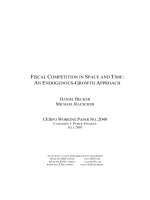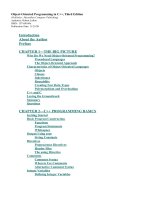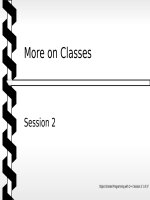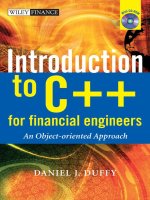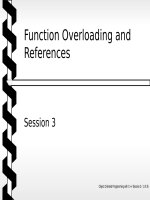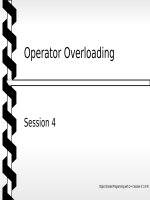Hedge fund modelling and analysis an object oriented approach using c
Bạn đang xem bản rút gọn của tài liệu. Xem và tải ngay bản đầy đủ của tài liệu tại đây (7.48 MB, 294 trang )
Hedge Fund
Modelling and
Analysis
The Wiley Finance series contains books written specifically for finance and investment
professionals as well as sophisticated individual investors and their financial advisors.
Book topics range from portfolio management to e-commerce, risk management, financial
engineering, valuation and financial instrument analysis, as well as much more. For a list
of available titles, visit our website at www.WileyFinance.com.
Founded in 1807, John Wiley & Sons is the oldest independent publishing company
in the United States. With offices in North America, Europe, Australia and Asia, Wiley
is globally committed to developing and marketing print and electronic products and services for our customers’ professional and personal knowledge and understanding.
Hedge Fund
Modelling and
Analysis
An Object Oriented Approach Using C++
PAUL DARBYSHIRE
DAVID HAMPTON
This edition first published 2017
© 2017 Paul Darbyshire and David Hampton
Registered office
John Wiley & Sons Ltd, The Atrium, Southern Gate, Chichester, West Sussex, PO19 8SQ, United
Kingdom
For details of our global editorial offices, for customer services and for information about how to apply
for permission to reuse the copyright material in this book please see our website at www.wiley.com.
The right of the author to be identified as the author of this work has been asserted in accordance with
the Copyright, Designs and Patents Act 1988.
All rights reserved. No part of this publication may be reproduced, stored in a retrieval system, or
transmitted, in any form or by any means, electronic, mechanical, photocopying, recording or
otherwise, except as permitted by the UK Copyright, Designs and Patents Act 1988, without the prior
permission of the publisher.
Wiley publishes in a variety of print and electronic formats and by print-on-demand. Some material
included with standard print versions of this book may not be included in e-books or in
print-on-demand. If this book refers to media such as a CD or DVD that is not included in the version
you purchased, you may download this material at . For more information
about Wiley products, visit www.wiley.com.
Designations used by companies to distinguish their products are often claimed as trademarks. All
brand names and product names used in this book are trade names, service marks, trademarks or
registered trademarks of their respective owners. The publisher is not associated with any product or
vendor mentioned in this book.
Limit of Liability/Disclaimer of Warranty: While the publisher and author have used their best efforts
in preparing this book, they make no representations or warranties with respect to the accuracy or
completeness of the contents of this book and specifically disclaim any implied warranties of
merchantability or fitness for a particular purpose. It is sold on the understanding that the publisher is
not engaged in rendering professional services and neither the publisher nor the author shall be liable
for damages arising herefrom. If professional advice or other expert assistance is required, the services
of a competent professional should be sought.
Library of Congress Cataloging-in-Publication Data is available
A catalogue record for this book is available from the British Library.
ISBN 978-1-118-87957-3 (hbk) ISBN 978-1-118-87955-9 (ebk)
ISBN 978-1-118-87956-6 (ebk) ISBN 978-1-118-87954-2 (ebk)
Cover Design: Wiley
Cover Images: Top Image: ©iStock.com/agsandrew
Bottom Image: ©iStock.com/Storman
Set in 11/13pt Times by Aptara Inc., New Delhi, India
Printed in Great Britain by TJ International Ltd, Padstow, Cornwall, UK
Mum and Dad,
Whose love and support encourages me to achieve success.
– P.D.
For Marie-Christine, Juliette and Antoine.
– D.H.
Contents
Preface
xi
CHAPTER 1
Essential C++
1
1.1 A Brief History of C and C++
1.2 A Basic C++ Program
1.3 Variables
1.3.1 Characters and Strings
1.3.2 Variable Declarations
1.3.3 Type Casting
1.3.4 Variable Scope
1.3.5 Constants
1.4 Operators
1.4.1 The Assignment Operator
1.4.2 Arithmetic Operators
1.4.3 Relational Operators
1.4.4 Logical Operators
1.4.5 Conditional Operator
1.5 Input and Output
1.6 Control Structures
1.6.1 Branching
1.6.2 Looping
1.6.3 The for Loop
1.6.4 The while Loop
1.6.5 The do … while Loop
1.7 Arrays
1.8 Vectors
1.9 Functions
1.9.1 Call-by-Value vs. Call-by-Reference
1.9.2 Overloading Functions
1.10 Object Oriented Programming
1.10.1 Classes and Abstract Data Types
1
2
4
5
8
9
10
11
12
12
14
15
16
17
18
21
21
25
25
27
29
30
31
33
36
39
41
42
vii
viii
CONTENTS
1.10.2
1.10.3
1.10.4
1.10.5
1.10.6
1.10.7
1.10.8
1.10.9
1.10.10
Encapsulation and Interfaces
Inheritance and Overriding Functions
Polymorphism
An Example of a Class
Getter and Setter Methods
Constructors and Destructors
A More Detailed Class Example
Implementing Inheritance
Operator Overloading
CHAPTER 2
The Hedge Fund Industry
2.1 What are Hedge Funds?
2.2 The Structure of a Hedge Fund
2.2.1 Fund Administrators
2.2.2 Prime Brokers
2.2.3 Custodian, Auditors and Legal
2.3 The Global Hedge Fund Industry
2.3.1 North America
2.3.2 Europe
2.3.3 Asia
2.4 Specialist Investment Techniques
2.4.1 Short Selling
2.4.2 Leverage
2.4.3 Liquidity
2.5 Recent Developments for Hedge Funds
2.5.1 UCITS Hedge Funds
2.5.2 The European Passport
2.5.3 Restrictions on Short Selling
CHAPTER 3
Hedge Fund Data Sources
3.1
3.2
Hedge Fund Databases
Major Hedge Fund Indices
3.2.1 Non-Investable and Investable Indices
3.2.2 Dow Jones Credit Suisse Hedge Fund Indices
(www.hedgeindex.com)
3.2.3 Hedge Fund Research (www.hedgefundresearch.com)
3.2.4 FTSE Hedge (www.ftse.com)
3.2.5 Greenwich Alternative Investments (www.greenwichai.com)
3.2.6 Morningstar Alternative Investment Center (www.
morningstar.com/advisor/alternative-investments.htm)
43
44
45
46
49
52
55
61
64
71
71
74
74
75
76
77
79
80
81
82
82
83
84
85
85
88
88
91
91
92
92
94
100
102
104
108
ix
Contents
3.2.7
EDHEC Risk and Asset Management Research Centre
(www.edhec-risk.com)
3.3 Database and Index Biases
3.3.1 Survivorship Bias
3.3.2 Instant History Bias
3.4 Benchmarking
3.4.1 Tracking Error
CHAPTER 4
Statistical Analysis
4.1 The Stats Class
4.2 The Utils Class
4.3 The Import Class
4.4 Basic Performance Plots
4.4.1 Value Added Index
4.4.2 Histograms
4.5 Probability Distributions
4.5.1 Populations and Samples
4.6 Probability Density Function
4.7 Cumulative Distribution Function
4.8 The Normal Distribution
4.8.1 Standard Normal Distribution
4.9 Visual Tests for Normality
4.9.1 Inspection
4.9.2 Normal Probability Plot
4.10 Moments of a Distribution
4.10.1 Mean and Standard Deviation
4.10.2 Skew
4.10.3 Kurtosis
4.11 Covariance and Correlation
4.12 Linear Regression
4.12.1 Coefficient of Determination
4.12.2 Residual Plots
CHAPTER 5
Performance Measurement
5.1
5.2
5.3
5.4
5.5
The PMetrics Class
The Intuition Behind Risk-Adjusted Returns
5.2.1 Risk-Adjusted Returns
Absolute Risk-Adjusted Return Metrics
The Sharpe Ratio
Market Models
112
113
113
115
115
116
119
119
120
123
127
127
130
131
132
133
134
134
136
136
136
137
138
138
141
142
146
158
163
167
173
173
174
182
184
187
191
x
CONTENTS
5.6
5.5.1 The Information Ratio
5.5.2 The Treynor Ratio
5.5.3 Jensen’s Alpha
5.5.4 M-Squared
The Minimum Acceptable Return
5.6.1 The Sortino Ratio
5.6.2 The Omega Ratio
CHAPTER 6
Mean-Variance Optimisation
6.1 The Optimise Class
6.2 Mean-Variance Analysis
6.2.1 Portfolio Return and Variance
6.2.2 The Mean-Variance Optimisation Problem
6.2.3 The Global Minimum Variance Portfolio
6.2.4 Short Sale Constraints
CHAPTER 7
Market Risk Management
7.1
7.2
7.3
The RMetrics Class
Value-at-Risk
Traditional VaR Methods
7.3.1 Historical Simulation
7.3.2 Parametric Method
7.3.3 Monte-Carlo Simulation
7.4 Modified VaR
7.5 Expected Shortfall
7.6 Extreme Value Theory
7.6.1 Block Maxima
7.6.2 Peaks Over Threshold
192
197
203
205
207
207
211
213
213
214
214
229
244
246
247
247
248
251
251
254
261
263
266
271
272
272
References
277
Index
279
Preface
his book is a practical introduction to modelling and analysing hedge funds using
the C++ programming language. The structure of the book is as follows. Chapter 1 gives an overview of the C++ syntax in enough detail to approach the material
covered in the technical chapters. Chapter 1 also introduces the concept of object oriented programming which allow us to build large and complex programs that can be
broken down into smaller self-contained reusable code units known as classes. We
will develop a series of classes throughout the book to tackle many of the problems
encountered. Please note that this book is not intended to be an exhaustive exploration
of C++ to solve problems in modelling and analysing hedge fund data. In addition,
C++ is used to facilitate the solution of such problems through object oriented programming methods and various details highlighted as and when necessary.
Chapters 2 and 3 give an update of the current state of the global hedge fund industry and a detailed look at the primary data sources available to hedge fund managers
and analysts. With this fundamental knowledge in place, Chapters 4–7 cover the more
quantitative and theoretical material needed to effectively analyse a series of hedge
fund returns and extract the relevant information required in order to make critical
investment decisions.
T
C++ SOURCE CODE
Throughout the book there are numerous C++ source boxes (e.g., Source 2.4) typically listing the AClass.h, AClass.cpp, and main.cpp files and a console window showing the results of the class implementation. For example, an extract from
the Optimise class is shown in Source P.1.
SOURCE P.1: A SAMPLE C++ SOURCE CODE
// Optimise.h
#pragma once;
xi
xii
PREFACE
#include "Matrix.h"
#include "Stats.h"
class Optimise: public Stats
{
public:
Optimise() {}
virtual ~Optimise() {}
// Member function declarations
Matrix PRet(const V2DD& v); // PRet()
Matrix PVar(const V2DD& v); // PVar()
private:
// Member variable declarations
Matrix m_matrix; // An instance of the Matrix class
};
// Optimise.cpp
#include "Optimise.h"
Matrix Optimise::PRet(const V2DD& v)
{
UINT n = v[0].size()-1;
// Declare wT and R matrices
Matrix wT = Matrix(1, n);
Matrix R = Matrix(n, 1);
// Transpose weights
for (UINT i=1; i<=n; i++)
wT(1, i) = 1 / (DBL)n; // Equal weights
// Mean returns
V1DD r = Mean(v, 12);
// R matrix
for (UINT i=1; i<=n; i++)
R(i, 1) = r[i-1];
return wT * R;
}
Matrix Optimise::PVar(const V2DD& v)
{
Preface
UINT n = v[0].size()-1;
// Declare w, wT and VCV matrices
Matrix w = Matrix(n, 1);
Matrix wT = Matrix(1, n);
Matrix VCV = Matrix(n, n);
// Initialise portfolio weights
for (int i=1; i<=n; i++)
w(i, 1) = 1 / (DBL)n; // Equal weights
// Transpose weights
for (int i=1; i<=n; i++)
wT(1, i) = 1 / (DBL)n; // Equal weights
// Covariance matrix
V1DD cov = Cov(v);
// VCV matrix
int k = 0; // Covariance offset
for (UINT i=1; i<=n; i++)
{
for (UINT j=1; j<=n; j++)
{
VCV(i, j) = cov[j+k-1];
if(i == j)
VCV(i, j) *= 12; // Annualise variance
}
k+=10;
}
return wT * VCV * w;
}
// ...
// main.cpp
// ...
// Create class instances
Import thfs;
Optimise optimise;
// Declare and call GetData()
V2DD data = thfs.GetData("./data/10_hedge_funds.dat");
xiii
xiv
PREFACE
// Declare and call PRet() and PVar() member function
Matrix pret = optimise.PRet(data);
Matrix pvar = optimise.PVar(data);
// Output results
cout << "\n Port. Ret. (%) = ";
pret.Print();
cout << " Port. Var. (%) = ";
pvar.Print();
// ...
Comment blocks, such as:
// ...
// main.cpp
// ...
are used to omit parts of the source code (above and below) when new code is added
to existing definitions or implementations. As we progress through the book we will
gradually reduce unnecessary overuse of comments (//) within source listings once
we feel confident we have clearly defined such routines and concepts in previous
listings.
Please note that we do not give any warranty for completeness, nor do we guarantee that the code is error free. Any damage or loss incurred in the application of
the C++ source code, algorithms and classes discussed in the book are entirely the
xv
Preface
TABLE P.1 10 Hypothetical Hedge Funds
Hedge Fund
Abbreviation
Commodity Trading Advisor
CTA1, CTA2, CTA3
Long Short Equity
LS1, LS2, LS3
Global Macro
GM1, GM2
Market Neutral
MN1, MN2
reader’s responsibility. If you notice any errors in the C++ source code, algorithms
or classes, or you wish to submit some new method as a C++ function, algorithm,
class, model or some improvement of the method illustrated in the book, you are very
welcome.
HYPOTHETICAL HEDGE FUND DATA
Throughout the book there is constant reference to many monthly hedge fund return
series. The 10 hedge funds are all hypothetical and have been simulated by the authors
as a unique data set for demonstration purposes only. The techniques and models used
in the book can therefore be tested on the hypothetical data before being applied to
real-life situations by the reader. The hypothetical data is nonetheless close to what
would be expected in reality. The 10 funds are a mixture of several major hedge fund
strategies i.e. Commodity Trading Advisor (CTA), Long/Short Equity (LS), Global
Macro (GM) and Market Neutral (MN) strategies as described in Table P.1.
All data files used throughout the book are identified in italics e.g.
10_hedge_funds.dat.
BOOK WEBSITE
The official website for the book is located at: www.darbyshirehampton.com
The website provides free downloads to all of the hypothetical data, C++ programs and classes, as well as many other useful resources.
The authors can be contacted on any matter relating to the book, or in a professional capacity, at the following email addresses:
Paul Darbyshire:
David Hampton:
Hedge Fund Modelling and Analysis: An Object
Oriented Approach Using C++
By Paul Darbyshire and David Hampton
© 2017 Paul Darbyshire and David Hampton
CHAPTER
1
Essential C++
his chapter covers the fundamental requirements necessary to allow the reader to
get up and running building quantitative models using the C++ programming language. This introduction is in no way intended to be an in-depth treatment of the C++
programming language but more an overview of the basics required to build your own
efficient and adaptable programs. Once the key concepts have been developed, objectoriented principles are introduced and many of the advantages of building quantitative systems using such programming approaches are outlined. It is assumed that the
reader will have some prerequisite knowledge of a low-level programming language
and the necessary computation skills to effectively grasp and apply the material presented here.
T
1.1 A BRIEF HISTORY OF C AND C++
C is a procedural1 programming language developed at Bell Laboratories between
1969 and 1973 for the UNIX operating system. Early versions of C were known as
K&R C after the publication of the book The C Programming Language written by
Brian Kernighan and Dennis Ritchie in 1978. However, as the language developed
and became more standardised, a version known as ANSI2 C became more prominent.
Although C is no longer the choice of many developers, there is still a huge amount of
legacy software coded in it that is actively maintained. Indeed, C has greatly influenced
other programming languages, in particular C++ which began purely as an extension
of C.
1
Procedural programming is a form of imperative programming in which a program is built from one or
more procedures i.e. subroutines or functions.
2
Founded in 1918, the American National Standards Institute (ANSI) is a private, non-profit membership
organisation that facilitates the development of American National Standards (ANS) by accrediting the
procedures of the Standards Developing Organizations (SDOs). These groups work cooperatively to
develop voluntary national consensus standards.
1
2
HEDGE FUND MODELLING AND ANALYSIS
Often described as a superset of the C language, C++ uses an entirely different set of programming concepts designed around the Object-Oriented Programming
(OOP) paradigm. Solving a computer problem with OOP involves the design of socalled classes that are abstractions of physical objects containing the state, members,
capabilities and methods of the object. C++ was initially developed by Bjarne Stroustrup in 1979 whilst at Bell Laboratories as an enhancement to C; originally known
as C with Classes. The language was renamed C++ in the early 80s and by 1998,
C++ was standardised as ANSI/ISO3 C++. During this time several new features
were added to the language, including virtual functions, operator overloading, multiple inheritance and exception handling. The ANSI/ISO standard is based on two main
components: the core language and the C++ Standard Library that incorporates the
C Standard Library with a number of modifications optimised for use with the C++
language. The C++ Standard Library also includes most of the Standard Template
Library (STL); a set of tools, such as containers and iterators that provide array-like
functionality, as well as algorithms designed specifically for sorting and searching
tasks. C++11 is the most recent complete overhaul of the C++ programming language approved by ANSI/ISO on 12 August 2011, replacing C++03, and superseded
by C++14 on 18 August 2014. The naming convention follows the tradition of naming
language versions by the year of the specification’s publication, although it was formerly known as C++0x to take into account many publication delays. C++14 is the
informal name for the most recent revision of the C++ ANSI/ISO standard, intended
to be a small extension over C++11, featuring mainly bug fixes and small syntax
improvements.
1.2 A BASIC C++ PROGRAM
Without doubt the best method of learning a programming language is to actually start
by writing and analysing programs. Source 1.1 implements a basic C++ program that
simply outputs a string of text, once the program has been compiled and executed, to
the console window. Although the program looks very simple it nevertheless contains
many of the fundamental components that every C++ program generally requires.
SOURCE 1.1: A BASIC C++ PROGRAM
// main.cpp
#include <windows.h>
#include <iostream>
3
The International Organisation for Standardisation (ISO) is an international standard-setting body
made up of representatives from a range of National Standards Organisations (NSOs).
Essential C++
3
using std::cout;
using std::cin;
int main()
{
SetConsoleTitle(L"Console Output"); // Set title of console
window
cout << "\n " << "Hedge Fund Modelling and Analysis: An Object
Oriented Approach Using C++";
cin.get(); // Pause console window
return 0; // Return null integer and exit
}
Statements beginning with a hash symbol (#) indicate directives to the preprocessor that initialise when the compiler is first invoked, in this case, to inform the compiler
that certain functions from the C++ Standard Library must be included. #include
<windows.h> gives the program access to certain functions in the library, such as
SetConsoleTitle() whilst #include <iostream> enables console input and
output (I/O). Typical objects in the iostream library include cin and cout which
are explicitly included through the using statement at the top of the program. Writing using std::cout at the top of the program avoids the need to keep retyping std through the scope resolution operator (::) every time cout is used. For
example, if we had not specified using std::cout we would have to explicitly
write std in front of each usage throughout the program, that is:
4
HEDGE FUND MODELLING AND ANALYSIS
std::cout << "\n " << "Hedge Fund Modelling and Analysis: An Object
Oriented Approach Using C++";
std::cin.get();
Although in this case there are only two occasions where we need std, you can
imagine how this could quickly clog up code for very large programs. Note also that
all C++ statements must end with a semi-colon (;).
A commonly identified problem with the C language is the issue of running out of
names for definitions and functions when programs reach very large sizes eventually
resulting in name clashes. Standard C++ has a mechanism to prevent such a clash
through the use of the namespace keyword. Each set of C++ definitions in a library
or program is wrapped into a namespace, and if some other definition has an identical
name, but is in a different namespace, then there is no conflict. All Standard C++
libraries are wrapped in a single namespace called std and invoked with the using
keyword:
using namespace std;
Whether to use using namespace std or explicitly state their use through
using std::cout, for example, is purely a preference of programming style. The
main reason we do not invoke using namespace std in our programs is that this
leaves us the opportunity of defining our own namespaces if we wish and it is generally
good practice to have only one namespace invocation in each program.
The main() function is the point at which all C++ programs start their execution
even if there are several other functions declared in the same program. For this reason,
it is an essential requirement that all C++ programs have a main() function within
the body at some point in the program. Once the text is output to the console window,
cin.get() is used to cause the program to pause so that the user can read the output
and then close and exit the window by pressing any key. Technically, in C or C++
the main() function must return a value because it is declared as int i.e. the main
function should return an integer data type. The int value that main() returns is
usually the value that will be passed back to the operating system; in this case it is 0
i.e. return 0 which indicates that the program ran successfully. It is not necessary
to state return 0 explicitly, because the compiler invokes this automatically when
main() terminates, but it is good practice to include a return type for all functions
(including main()).
1.3 VARIABLES
A variable is a name associated with a portion of memory used to store and manipulate
the data associated with that variable. The compiler sets aside a specific amount of
memory space to store the data assigned to the variable and associates the variable
name with that memory address. As the name implies, variables can be changed within
a program as and when required. When new data is assigned to the same variable, the
old data is overwritten and restored in the same memory address. The data stored in a
Essential C++
5
TABLE 1.1 Reserved C++ keywords
asm, auto, bool, break, case, catch, char, class, const,
const_cast, continue, default, delete, do, double,
dynamic_cast, else, enum, explicit, export, extern, false,
float, for, friend, goto, if, inline, int, long, mutable,
namespace, new, operator, private, protected, public,
register, reinterpret_cast, return, short, signed, sizeof,
static, static_cast, struct, switch, template, this,
throw, true, try, typedef, typeid, typename, union,
unsigned, using, virtual, void, volatile, wchar_t, while
variable is only temporary and only exists as long as the variable itself exists (defined
by the scope of the variable). If the data stored in a variable is required beyond its
existence then it must be written to a permanent storage device, such as a disk or file.
A variable name can be any length and composed of lower and upper case letters,
numbers and the underscore (_) character, but keep in mind that variables are casesensitive. In practice, a programmer will usually develop their own variable naming
convention but bear in mind that C++ reserves certain keywords for variable names
so try not to clash with these. Table 1.1 shows a list of reserved C++ keywords.
There are sevenal built-in data types provided by C++ along with specific type
modifiers to further quantify the data. A complete list of all the data types and their
associated modifiers are described in Table 1.2.
In Table 1.2, other than char (which has a size of exactly one byte), none of
the fundamental types has a standard size (only a minimum size, at most). This does
not mean that these types are of an undetermined size, but that there is no standard
size across all compilers and machines; each compiler implementation can specify
the sizes that best fit the architecture where the program is going to be executing. This
rather generic size specification of data types allows the C++ language a lot of flexibility in adapting to work optimally on all kinds of platforms, both present and future.
1.3.1 Characters and Strings
When using the char data type, we use single quotes, for example:
char Stock = 'MSFT';
Certain characters, such as single ('') and double ("") quotes have special meaning in C++ and have to be treated with care. In addition, C++ reserves special
characters for formatting text and other processing tasks known as character escape
sequences (or backslash character constants) as shown in Table 1.3.
A more versatile data type than char is string which can be a combination of
characters, numbers, spaces and symbols of any length. C++ does not have a built-in
data type to hold strings instead it is defined in the C++ Standard Library through
the inclusion of the header file <string>. An example of using string variables is
shown in Source 1.2.
6
HEDGE FUND MODELLING AND ANALYSIS
TABLE 1.2 Common C++ data types
Name
Description
char
Size
(Bytes)
Range
1
-128 to 127
1
0 to 255 (ASCII characters)
signed char
1
-128 to 127 (ASCII characters)
int
4
-2,147,483,648 to
2,147,483,647
unsigned int
4
0 to 4,294,967,295
signed int
4
-2,147,483,648 to
2,147,483,647
2
-32,768 to 32,767
unsigned short int
2
0 to 65,535
signed short int
2
-32,768 to 32,767
long int
4
Same as int
unsigned long int
4
Same as unsigned int
signed long int
4
Same as signed int
unsigned char
short int
Character
Integer number
float
Floating point number
4
3.4E-38 to 3.4E+38
double
8
1.7E-308 to 1.7E+308
long double
Double precision
floating point number
bool
Boolean value
string
As required
wchar_t
Wide character
10
3.4E-4932 to 1.1E+4932
1
True or False
Any length
2
0 to 65,535
TABLE 1.3 Character escape sequences
Sequence
Output
\n
New line
\t
Tab
\b
Back space
\?
Question mark
\f
Page feed
\a
Alert (beep)
\\
Backslash
\’
Single quote
\”
Double quote
Essential C++
SOURCE 1.2: STRING VARIABLES
// main.cpp
#include <windows.h>
#include <iostream>
#include <string>
using std::cout;
using std::cin;
using std::string;
int main()
{
SetConsoleTitle(L"Console Output"); // Set title of console
window
//declare two string variables
string strFirstName = "Paul";
string strLastName = "Darbyshire";
//concatenate the two strings
string strFullName = strFirstName + " " + strLastName;
cout << "\n " << strFullName;
cin.get(); // Pause console window
return 0; // Return null integer and exit
}
7
8
HEDGE FUND MODELLING AND ANALYSIS
In Source 1.2, two string variables are declared and initialised and then joined
together to form another string. The (+) symbol is used for joining (or concatenating)
two variables together, and in this context the (+) symbol is often referred to as the
concatenation operator.
1.3.2 Variable Declarations
Before a variable can be used in a program it must first be declared as shown in
Source 1.3. Declaring the variable and its data type allows the compiler to set aside
the appropriate amount of memory for storage and subsequent manipulation.
SOURCE 1.3: DECLARING VARIABLES
// ...
// Declare variables
int x, y;
int result;
// Assign values
x = 4;
y = 2;
x = x + 1;
//Do something
result = x - y;
cout << "\n " << result << "\n ";
// ...
Essential C++
9
It is possible to declare more than one variable of the same type in the same declaration statement. It is also possible to assign initial values to variables whilst they
are being declared through the process of initialisation, for example:
int x, y = 4, z = 3;
There is another useful method of initialising a variable known as constructor
initialisation:
int x(0);
1.3.3 Type Casting
One way to force an expression to produce a result that is of a different type to the
variables declared in the expression is to use a construct called cast (i.e. type casting).
Source 1.4 shows an example of declaring two variables as int and dividing them to
produce an int and double division through type casting.
SOURCE 1.4: TYPE CASTING
// ...
int a = 6, b = 4;
cout << "\n " << a/b << "\n"; // Integer division
cout << " " << (double)a/b << "\n "; // Type casting to double
division
// ...
10
HEDGE FUND MODELLING AND ANALYSIS
Note that type casting will not change the type of the variables from integer only
the type of the result to double.
1.3.4 Variable Scope
A variable can have either global (i.e. public) or local (i.e. private) scope depending
on where it is declared within the program. Any variables declared with global scope
should be prefixed with the keyword const. An example is shown in Source 1.5.
SOURCE 1.5: VARIABLE SCOPE
// ...
// GLOBAL variable
int globalN = 144;
int main()
{
SetConsoleTitle(L"Console Output"); // Set title of console
window
// LOCAL variable
int localN = 72;
cout << "\n " << "# of data points (LOCAL) = " << localN;
cout << "\n " << "# of data points (GLOBAL) = " << globalN;
cin.get(); // Pause console window
return 0; // Return null integer and exit
}
Essential C++
11
In Source 1.5, you can see that the variable globalN has been declared globally
and initialised to the value 144. Global variables can be accessed from anywhere in
the program once they have been declared. Local variables, on the other hand, such
as localN can only be used within the block enclosed by the braces ({}) in which it
is declared.
1.3.5 Constants
Constants are fixed values assigned to variables that cannot be changed once they have
been declared and initialised. We have already used literal constants when a variable
was declared and initialised in Source 1.2:
string FirstName = "Paul";
Or, as in Source 1.5:
int localN = 72;
With symbolic constants the const keyword is used in front of the declaration
and initialisation, for example:
const double Volatility = 0.18;
Enumerated constants are an alternative way of creating a series of integer constants. Suppose you wanted to assign an integer value of 0 to 6 to the days of the week
starting at Sunday. This could be achieved using a list of symbolic constants written as:
const int Sun = 0;
const int Mon = 1;
const int Tue = 2; etc.
However, with enumeration it is possible to write:
enum WeekDays
{
Sun,
Mon,
Tue,
Wed,
Thu,
Fri,
Sat
};
